Guangxuan Xu
A Probabilistic Inference Approach to Inference-Time Scaling of LLMs using Particle-Based Monte Carlo Methods
Feb 04, 2025Abstract:Large language models (LLMs) have achieved significant performance gains via scaling up model sizes and/or data. However, recent evidence suggests diminishing returns from such approaches, motivating scaling the computation spent at inference time. Existing inference-time scaling methods, usually with reward models, cast the task as a search problem, which tends to be vulnerable to reward hacking as a consequence of approximation errors in reward models. In this paper, we instead cast inference-time scaling as a probabilistic inference task and leverage sampling-based techniques to explore the typical set of the state distribution of a state-space model with an approximate likelihood, rather than optimize for its mode directly. We propose a novel inference-time scaling approach by adapting particle-based Monte Carlo methods to this task. Our empirical evaluation demonstrates that our methods have a 4-16x better scaling rate over our deterministic search counterparts on various challenging mathematical reasoning tasks. Using our approach, we show that Qwen2.5-Math-1.5B-Instruct can surpass GPT-4o accuracy in only 4 rollouts, while Qwen2.5-Math-7B-Instruct scales to o1 level accuracy in only 32 rollouts. Our work not only presents an effective method to inference-time scaling, but also connects the rich literature in probabilistic inference with inference-time scaling of LLMs to develop more robust algorithms in future work. Code and further information is available at https://probabilistic-inference-scaling.github.io.
Unveiling the Secret Recipe: A Guide For Supervised Fine-Tuning Small LLMs
Dec 17, 2024Abstract:The rise of large language models (LLMs) has created a significant disparity: industrial research labs with their computational resources, expert teams, and advanced infrastructures, can effectively fine-tune LLMs, while individual developers and small organizations face barriers due to limited resources. In this paper, we aim to bridge this gap by presenting a comprehensive study on supervised fine-tuning of LLMs using instruction-tuning datasets spanning diverse knowledge domains and skills. We focus on small-sized LLMs (3B to 7B parameters) for their cost-efficiency and accessibility. We explore various training configurations and strategies across four open-source pre-trained models. We provide detailed documentation of these configurations, revealing findings that challenge several common training practices, including hyperparameter recommendations from TULU and phased training recommended by Orca. Key insights from our work include: (i) larger batch sizes paired with lower learning rates lead to improved model performance on benchmarks such as MMLU, MTBench, and Open LLM Leaderboard; (ii) early-stage training dynamics, such as lower gradient norms and higher loss values, are strong indicators of better final model performance, enabling early termination of sub-optimal runs and significant computational savings; (iii) through a thorough exploration of hyperparameters like warmup steps and learning rate schedules, we provide guidance for practitioners and find that certain simplifications do not compromise performance; and (iv) we observed no significant difference in performance between phased and stacked training strategies, but stacked training is simpler and more sample efficient. With these findings holding robustly across datasets and models, we hope this study serves as a guide for practitioners fine-tuning small LLMs and promotes a more inclusive environment for LLM research.
Fantastic LLMs for Preference Data Annotation and How to (not) Find Them
Nov 04, 2024Abstract:Preference tuning of large language models (LLMs) relies on high-quality human preference data, which is often expensive and time-consuming to gather. While existing methods can use trained reward models or proprietary model as judges for preference annotation, they have notable drawbacks: training reward models remain dependent on initial human data, and using proprietary model imposes license restrictions that inhibits commercial usage. In this paper, we introduce customized density ratio (CDR) that leverages open-source LLMs for data annotation, offering an accessible and effective solution. Our approach uses the log-density ratio between a well-aligned LLM and a less aligned LLM as a reward signal. We explores 221 different LLMs pairs and empirically demonstrate that increasing the performance gap between paired LLMs correlates with better reward generalization. Furthermore, we show that tailoring the density ratio reward function with specific criteria and preference exemplars enhances performance across domains and within target areas. In our experiment using density ratio from a pair of Mistral-7B models, CDR achieves a RewardBench score of 82.6, outperforming the best in-class trained reward functions and demonstrating competitive performance against SoTA models in Safety (91.0) and Reasoning (88.0) domains. We use CDR to annotate an on-policy preference dataset with which we preference tune Llama-3-8B-Instruct with SimPO. The final model achieves a 37.4% (+15.1%) win rate on ArenaHard and a 40.7% (+17.8%) win rate on Length-Controlled AlpacaEval 2.0, along with a score of 8.0 on MT-Bench.
BRAIn: Bayesian Reward-conditioned Amortized Inference for natural language generation from feedback
Feb 04, 2024



Abstract:Following the success of Proximal Policy Optimization (PPO) for Reinforcement Learning from Human Feedback (RLHF), new techniques such as Sequence Likelihood Calibration (SLiC) and Direct Policy Optimization (DPO) have been proposed that are offline in nature and use rewards in an indirect manner. These techniques, in particular DPO, have recently become the tools of choice for LLM alignment due to their scalability and performance. However, they leave behind important features of the PPO approach. Methods such as SLiC or RRHF make use of the Reward Model (RM) only for ranking/preference, losing fine-grained information and ignoring the parametric form of the RM (eg., Bradley-Terry, Plackett-Luce), while methods such as DPO do not use even a separate reward model. In this work, we propose a novel approach, named BRAIn, that re-introduces the RM as part of a distribution matching approach.BRAIn considers the LLM distribution conditioned on the assumption of output goodness and applies Bayes theorem to derive an intractable posterior distribution where the RM is explicitly represented. BRAIn then distills this posterior into an amortized inference network through self-normalized importance sampling, leading to a scalable offline algorithm that significantly outperforms prior art in summarization and AntropicHH tasks. BRAIn also has interesting connections to PPO and DPO for specific RM choices.
Are Fairy Tales Fair? Analyzing Gender Bias in Temporal Narrative Event Chains of Children's Fairy Tales
May 26, 2023Abstract:Social biases and stereotypes are embedded in our culture in part through their presence in our stories, as evidenced by the rich history of humanities and social science literature analyzing such biases in children stories. Because these analyses are often conducted manually and at a small scale, such investigations can benefit from the use of more recent natural language processing methods that examine social bias in models and data corpora. Our work joins this interdisciplinary effort and makes a unique contribution by taking into account the event narrative structures when analyzing the social bias of stories. We propose a computational pipeline that automatically extracts a story's temporal narrative verb-based event chain for each of its characters as well as character attributes such as gender. We also present a verb-based event annotation scheme that can facilitate bias analysis by including categories such as those that align with traditional stereotypes. Through a case study analyzing gender bias in fairy tales, we demonstrate that our framework can reveal bias in not only the unigram verb-based events in which female and male characters participate but also in the temporal narrative order of such event participation.
NECE: Narrative Event Chain Extraction Toolkit
Aug 19, 2022



Abstract:NECE is an event-based text analysis toolkit built for narrative documents. NECE aims to provide users open and easy accesses to an event-based summary and abstraction of long narrative documents through both a graphic interface and a python package, which can be readily used in narrative analysis, understanding, or other advanced purposes. Our work addresses the challenge of long passage events extraction and temporal ordering of key events; at the same time, it offers options to select and view events related to narrative entities, such as main characters and gender groups. We conduct human evaluation to demonstrate the quality of the event chain extraction system and character features mining algorithms. Lastly, we shed light on the toolkit's potential downstream applications by demonstrating its usage in gender bias analysis and Question-Answering tasks.
Non-Parallel Text Style Transfer with Self-Parallel Supervision
Apr 18, 2022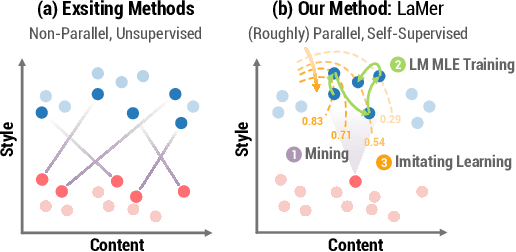
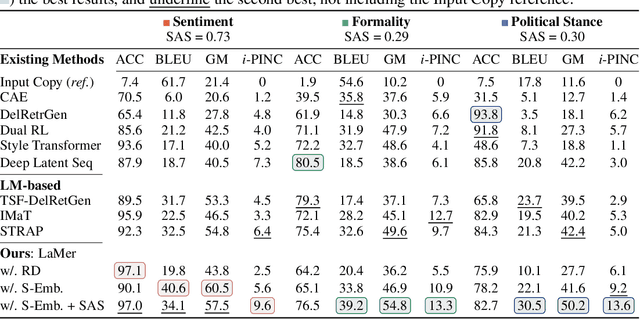
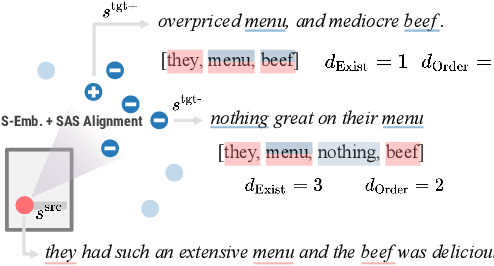

Abstract:The performance of existing text style transfer models is severely limited by the non-parallel datasets on which the models are trained. In non-parallel datasets, no direct mapping exists between sentences of the source and target style; the style transfer models thus only receive weak supervision of the target sentences during training, which often leads the model to discard too much style-independent information, or utterly fail to transfer the style. In this work, we propose LaMer, a novel text style transfer framework based on large-scale language models. LaMer first mines the roughly parallel expressions in the non-parallel datasets with scene graphs, and then employs MLE training, followed by imitation learning refinement, to leverage the intrinsic parallelism within the data. On two benchmark tasks (sentiment & formality transfer) and a newly proposed challenging task (political stance transfer), our model achieves qualitative advances in transfer accuracy, content preservation, and fluency. Further empirical and human evaluations demonstrate that our model not only makes training more efficient, but also generates more readable and diverse expressions than previous models.
Can Model Compression Improve NLP Fairness
Jan 21, 2022



Abstract:Model compression techniques are receiving increasing attention; however, the effect of compression on model fairness is still under explored. This is the first paper to examine the effect of distillation and pruning on the toxicity and bias of generative language models. We test Knowledge Distillation and Pruning methods on the GPT2 model and found a consistent pattern of toxicity and bias reduction after model distillation; this result can be potentially interpreted by existing line of research which describes model compression as a regularization technique; our work not only serves as a reference for safe deployment of compressed models, but also extends the discussion of "compression as regularization" into the setting of neural LMs, and hints at the possibility of using compression to develop fairer models.
On the Safety of Conversational Models: Taxonomy, Dataset, and Benchmark
Oct 16, 2021



Abstract:Dialogue safety problems severely limit the real-world deployment of neural conversational models and attract great research interests recently. We propose a taxonomy for dialogue safety specifically designed to capture unsafe behaviors that are unique in human-bot dialogue setting, with focuses on context-sensitive unsafety, which is under-explored in prior works. To spur research in this direction, we compile DiaSafety, a dataset of 6 unsafe categories with rich context-sensitive unsafe examples. Experiments show that existing utterance-level safety guarding tools fail catastrophically on our dataset. As a remedy, we train a context-level dialogue safety classifier to provide a strong baseline for context-sensitive dialogue unsafety detection. With our classifier, we perform safety evaluations on popular conversational models and show that existing dialogue systems are still stuck in context-sensitive safety problems.
Mitigating Political Bias in Language Models Through Reinforced Calibration
Apr 30, 2021
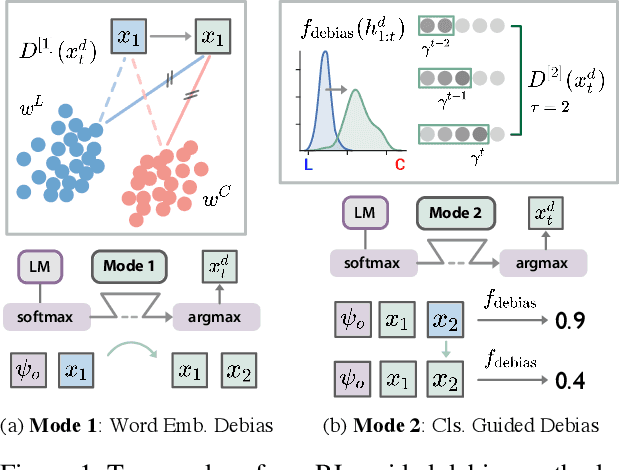

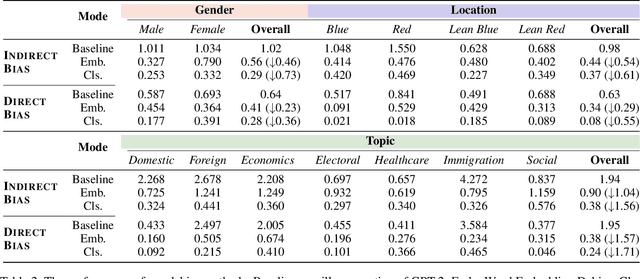
Abstract:Current large-scale language models can be politically biased as a result of the data they are trained on, potentially causing serious problems when they are deployed in real-world settings. In this paper, we describe metrics for measuring political bias in GPT-2 generation and propose a reinforcement learning (RL) framework for mitigating political biases in generated text. By using rewards from word embeddings or a classifier, our RL framework guides debiased generation without having access to the training data or requiring the model to be retrained. In empirical experiments on three attributes sensitive to political bias (gender, location, and topic), our methods reduced bias according to both our metrics and human evaluation, while maintaining readability and semantic coherence.
 Add to Chrome
Add to Chrome Add to Firefox
Add to Firefox Add to Edge
Add to Edge